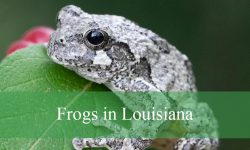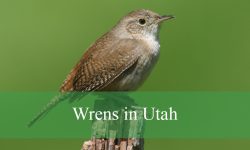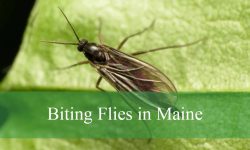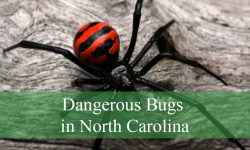Maryland hosts a variety of lizards that inhabit its forests, rocky hills, and even suburban environments. These reptiles play an important role in controlling insects and maintaining ecological balance.
Each species has its own unique habits and adaptations. Some lizards prefer the forest floor, while others climb trees or walls, displaying distinctive colors and behaviors that help them survive and thrive.
In this guide, you’ll learn about the five types of lizards in Maryland, complete with pictures and identification tips to spot them in the wild and appreciate their diversity.
Different Types of Lizards Found in Maryland
Five-lined Skink (Plestiodon fasciatus)
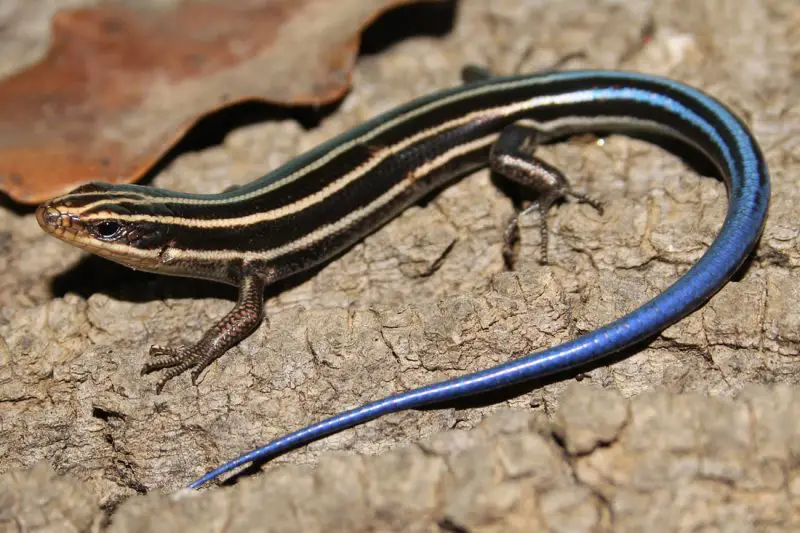
The Five-lined Skink is the most widespread and frequently encountered lizard in Maryland. It is a medium-sized skink that can grow from 5 to 8.5 inches (12–21 cm) in total length, including its tail. The species gets its name from the five distinct cream or yellow stripes that run longitudinally down its glossy, dark brown to black body. Juveniles are particularly eye-catching, with brilliant blue tails that serve as a defense mechanism—distracting predators away from the more vulnerable body. As these skinks age, the vivid blue fades, and adult males may develop a reddish or orange tint on their jaws and head, especially during the breeding season.
In terms of identification, the Five-lined Skink can be distinguished from similar species like the Broad-headed Skink by its smaller size and narrower head. Its smooth, shiny scales give it a sleek appearance, and its legs are relatively short but strong, built for fast movement across forest floors and rocky surfaces. Males tend to be more robust with brighter coloration, while females retain more visible striping throughout adulthood.
Behaviorally, this species is diurnal, spending much of the day basking on logs, tree trunks, or sunny rocks to regulate body temperature. They are agile and quick, darting into crevices or leaf litter when startled. Five-lined Skinks feed primarily on insects, spiders, snails, and other small invertebrates, playing an important role in controlling pest populations. During the breeding season, males may display territorial behavior, while females exhibit a surprising degree of maternal care, guarding their eggs until hatching—an uncommon trait among reptiles.
Their preferred habitat includes moist woodlands, forest edges, and areas with abundant cover such as fallen logs, leaf litter, and rock piles. They are especially fond of environments that offer both shade and sunny basking spots. In suburban areas, they can sometimes be found around stone walls, gardens, and firewood stacks. The species is highly adaptable and can tolerate a variety of microhabitats as long as moisture and shelter are available.
In Maryland, the Five-lined Skink has an extensive distribution, being found throughout central, western, and southern regions of the state. They are especially common in the Piedmont Plateau and Appalachian Mountains, where suitable woodland habitats are abundant. They are less frequent on the coastal plain but can still be encountered in forested patches and residential areas. Their wide range and adaptability make them one of the most successful lizard species in the state, contributing to Maryland’s reptilian diversity.
Broad-headed Skink (Plestiodon laticeps)
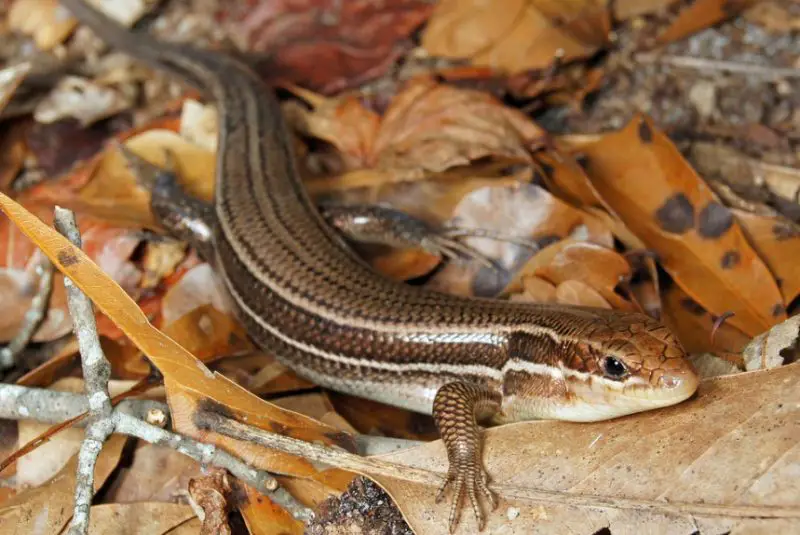
The Broad-headed Skink is the largest lizard species found in Maryland, capable of reaching an impressive total length of up to 13 inches (33 cm). As its name suggests, this skink is distinguished by its broad, triangular head, which gives it a powerful and muscular appearance. Adult males are especially striking during the breeding season when their heads develop a vivid orange or red coloration, contrasting with their otherwise olive-brown or grayish bodies. Females and juveniles, on the other hand, tend to display five faint light stripes running down the back and sides, a feature that fades with age.
In terms of identification, the Broad-headed Skink can be confused with the Five-lined Skink, but it can be differentiated by its larger size, heavier build, and wider jaws. Males often exhibit reduced or no striping as adults, while females retain a more patterned appearance. The scales are smooth and glossy, giving the lizard a sleek, polished look. Juveniles closely resemble young Five-lined Skinks, complete with a bright blue tail, though their heads are proportionally broader even at an early age.
Behaviorally, the Broad-headed Skink is primarily arboreal, meaning it spends a great deal of time climbing trees, especially oaks and pines. It is an agile climber that uses its strong limbs and claws to scale vertical surfaces quickly. These skinks often bask on tree trunks, fallen logs, or sunny branches and retreat into hollow cavities or under loose bark when threatened. They are diurnal and opportunistic feeders, preying on insects, spiders, snails, and occasionally smaller lizards. Males may defend territories and compete aggressively during the breeding season, using their strong jaws in combat.
The Broad-headed Skink’s breeding behavior is particularly interesting—females lay eggs in moist, protected sites such as decaying logs or under leaf litter. Like their Five-lined relatives, they exhibit maternal care, guarding the eggs until they hatch, which typically occurs after about 40 to 60 days depending on temperature and humidity. Hatchlings are tiny but already capable of climbing and foraging independently shortly after emerging.
When it comes to habitat, Broad-headed Skinks prefer mature deciduous and mixed forests, especially those dominated by oak and hickory trees that offer both canopy cover and suitable nesting sites. They thrive in warm, humid environments with abundant leaf litter and fallen timber. While primarily forest dwellers, they can also be found in suburban settings with large trees, wooded parks, or even near old fences and woodpiles.
In Maryland, this species is most common in the southern and eastern regions, including the Coastal Plain and parts of the lower Piedmont. They are less abundant in the mountainous west, where cooler temperatures limit their activity. Within their range, they are an important component of the local ecosystem, helping control insect populations and serving as prey for snakes and birds of prey. Their striking appearance and bold behavior make them one of Maryland’s most fascinating native reptiles.
Little Brown Skink (Scincella lateralis)
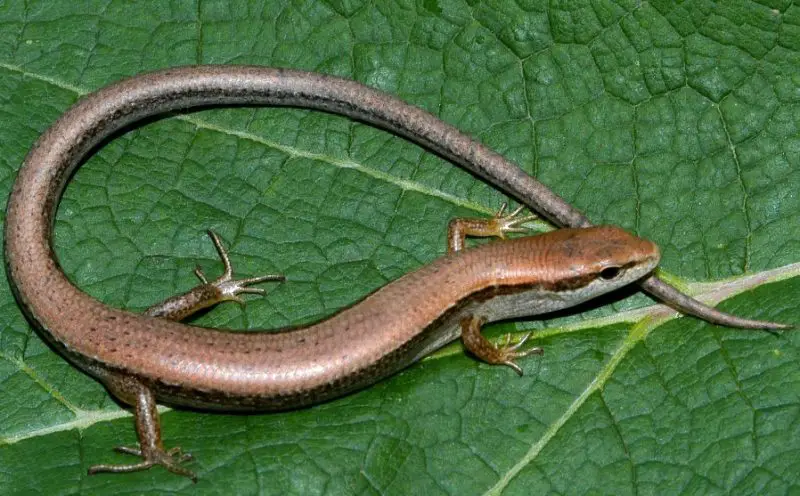
The Little Brown Skink, also known as the Ground Skink, is Maryland’s smallest lizard species, typically measuring only 3 to 5.5 inches (7.5–14 cm) in total length. Its diminutive size, combined with its smooth, glossy scales, gives it a delicate, almost snake-like appearance when it moves swiftly across the forest floor. The coloration is generally a uniform bronze, coppery, or light brown, often accented by a thin, dark stripe running along each side from the snout through the tail. The belly is pale or whitish, creating a subtle contrast with the upper body.
Identification of this species is relatively easy once its small size and ground-dwelling habits are noted. Unlike other skinks that often climb trees or bask on rocks, the Little Brown Skink almost never leaves the ground. Its scales are very fine and tightly arranged, providing a sleek sheen that helps reduce friction when it moves through leaf litter or soil. Its short legs and tail-to-body ratio make it well adapted for burrowing and darting under debris, an important survival strategy for avoiding predators.
Behaviorally, this skink is highly secretive and elusive, spending much of its life concealed beneath fallen leaves, logs, rocks, or other surface cover. It is an excellent burrower, capable of wriggling quickly through soft soil and detritus to escape danger. Its small size allows it to occupy microhabitats that larger lizards cannot access. The Little Brown Skink is diurnal, emerging during the warmer parts of the day to hunt for tiny invertebrates such as ants, termites, spiders, and small beetles. Despite its timid nature, it is remarkably quick and can vanish from sight in seconds when disturbed.
During the breeding season, which occurs in spring and early summer, females lay small clutches of eggs—usually 2 to 5 per nest—in moist soil or decaying wood. The female provides minimal care, but the carefully chosen nesting site ensures the eggs remain warm and humid. Hatchlings are miniature replicas of the adults, already capable of foraging and evading predators shortly after emerging.
In terms of habitat, the Little Brown Skink shows a strong preference for moist, shaded woodlands, particularly those with ample ground cover and loose, loamy soil. It thrives in forest edges, near streams, or in damp ravines where humidity is consistently high. Because it spends nearly all its time close to or under the soil surface, it is rarely seen basking in open sunlight.
In Maryland, this species is found primarily in the southern part of the state, especially in the Coastal Plain and lower Piedmont regions. It is less common farther north and west, where cooler temperatures and drier forests limit its distribution. Within its range, the Little Brown Skink plays an important ecological role in maintaining soil health and controlling insect populations. Its subtle beauty, secretive habits, and ground-dwelling lifestyle make it one of Maryland’s most unique and understated reptile species.
Eastern Fence Lizard (Sceloporus undulatus)
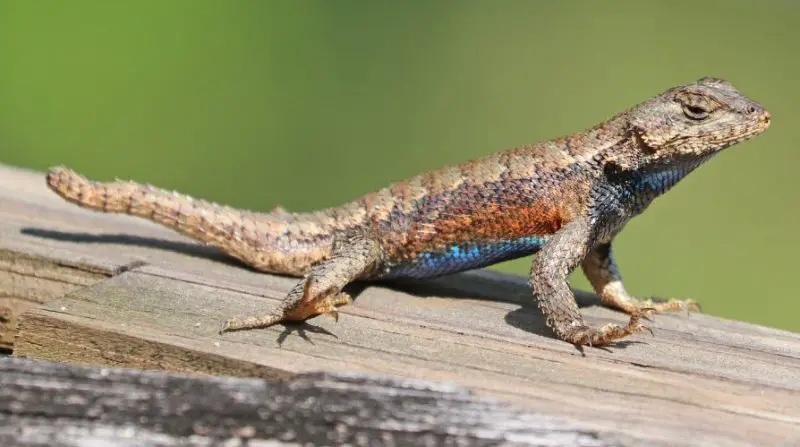
The Eastern Fence Lizard, sometimes known as the Prairie Lizard or Pine Lizard, is Maryland’s only spiny lizard species, easily distinguished by its rough, keeled scales that give it a coarse texture. Adults typically range from 4 to 7.5 inches (10–19 cm) in total length, including the tail. Their coloration is usually gray to brown, with a series of dark, wavy crossbands running across the back and tail. The belly is lighter, often white or pale gray, while males develop striking blue patches on their throats and along the sides of their bellies—most prominent during the breeding season when they use these markings to attract females and ward off rivals.
In terms of identification, the Eastern Fence Lizard stands apart from Maryland’s smooth-scaled skinks through its spiny scales, blockier head, and rugged body texture. Females tend to have duller coloring with less distinct blue markings, but their crossbands are typically more visible. Juveniles resemble adult females in pattern but are smaller and more subtly colored. When basking, their coloration can change slightly depending on temperature—darker when cold to absorb heat and lighter when warm to reflect it.
Behaviorally, the Eastern Fence Lizard is diurnal and highly active, spending much of the day basking on logs, rocks, fence posts, or sunny tree trunks. Its name “fence lizard” comes from its habit of perching on vertical surfaces, where it can quickly escape predators by darting upward into the bark or crevices. These lizards are territorial, with males displaying push-up movements, head bobs, and body flattening as dominance or courtship displays. Their diet consists mainly of insects, spiders, and other small arthropods, making them valuable natural pest controllers.
During the breeding season in late spring, females lay 5 to 15 eggs in shallow nests dug into sandy or loose soil, often in sunny, open areas. Incubation lasts around two months, and the hatchlings emerge in midsummer as fully independent, miniature versions of the adults. Unlike skinks, the Eastern Fence Lizard does not guard its eggs, relying instead on the warmth and dryness of the nesting site for proper development.
The species prefers dry, open habitats such as pine forests, rocky hillsides, woodland edges, and clearings. They are especially abundant in areas with scattered trees and plenty of sun exposure, where basking sites and hiding spots are both available. Their rough scales and cryptic coloration allow them to blend seamlessly with bark and stone, providing excellent camouflage against predators like snakes and birds.
In Maryland, the Eastern Fence Lizard is most common in the western and central regions, particularly across the Piedmont Plateau and Appalachian foothills. They are rare or absent from the Coastal Plain, where humid conditions and fewer rocky habitats make the environment less suitable. Their presence in an ecosystem often indicates healthy, well-drained woodland conditions. With their bold appearance and lively behavior, Eastern Fence Lizards are among Maryland’s most fascinating and visually distinctive reptiles.
Mediterranean House Gecko (Hemidactylus turcicus)
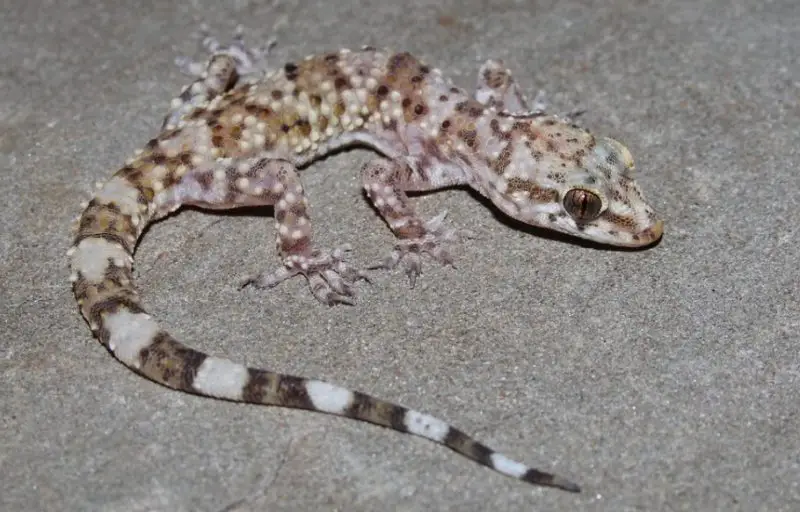
The Mediterranean House Gecko is an introduced, non-native species that has successfully established small populations in certain areas of Maryland, especially where human development provides warm, sheltered environments. This small lizard typically measures 4 to 6 inches (10–15 cm) in total length, with a semi-translucent body that ranges in color from pale gray to pinkish-tan. Its skin is covered in small, wart-like bumps, giving it a textured appearance, and the tail is segmented and somewhat flattened. One of its most distinctive features is its large, lidless eyes with vertical pupils, perfectly adapted for night vision.
Identification is relatively easy because of its translucent skin and climbing ability. Under bright light, the internal organs may even be faintly visible through the belly. Its toe pads are broad and equipped with tiny adhesive structures that allow it to cling to smooth vertical surfaces such as glass, stucco, or painted walls. This feature makes it a familiar sight around homes, where it often rests motionless on ceilings or near outdoor lights. Unlike native Maryland lizards, the Mediterranean House Gecko is nocturnal, emerging only after dark to hunt.
Behaviorally, this species is a quiet and efficient nocturnal predator, feeding primarily on moths, flies, mosquitoes, spiders, and other small insects drawn to artificial lights. They are most active on warm summer nights and can often be seen near porch lights, garages, and window frames. Males sometimes emit a series of soft chirping or clicking calls, especially during mating season or territorial disputes—sounds that are unusual among lizards found in Maryland. They rely on camouflage and agility rather than aggression, retreating quickly into cracks or behind shutters when disturbed.
The breeding season generally occurs from late spring through summer. Females lay small clutches of one or two eggs in hidden locations such as wall crevices, under rocks, or inside buildings. The eggs have hard, calcareous shells that resist drying out, allowing the species to reproduce successfully even in arid or artificial environments. Hatchlings are miniature versions of the adults and are independent from birth, reaching maturity within their first year.
As a species adapted to human presence, the Mediterranean House Gecko thrives in urban, suburban, and coastal habitats. It prefers warm, sheltered microclimates such as attics, basements, and building exteriors where temperatures remain mild year-round. Unlike native skinks or fence lizards, it does not rely on natural woodlands or rocky outcrops for survival. Its tolerance for artificial structures and mild winters has allowed it to expand slowly northward from its original range in the southern United States.
In Maryland, the Mediterranean House Gecko is found mainly in the southern and coastal regions, particularly near towns, ports, and urbanized areas along the Chesapeake Bay. Its presence is still considered sporadic and localized, as the cooler climate of northern Maryland limits its spread. Nonetheless, sightings are becoming more frequent as temperatures warm and urban heat islands create favorable microhabitats. While not considered invasive or ecologically disruptive, this adaptable gecko represents one of the few non-native lizard species successfully living alongside Maryland’s native reptiles.
FAQs About Lizards in Maryland
What kinds of lizards can be found in Maryland?
Maryland is home to five main types of lizards: the Five-lined Skink (Plestiodon fasciatus), Broad-headed Skink (Plestiodon laticeps), Little Brown Skink (Scincella lateralis), Eastern Fence Lizard (Sceloporus undulatus), and the introduced Mediterranean House Gecko (Hemidactylus turcicus). These species represent a mix of native woodland reptiles and one urban-adapted newcomer.
Are there any dangerous lizards in Maryland?
No, none of Maryland’s native or introduced lizards are dangerous to humans. All species are non-venomous, shy, and prefer to flee rather than bite. Even when handled, most lizards will only drop their tails as a defense mechanism, a harmless act called autotomy.
Where are lizards most commonly found in Maryland?
Lizards in Maryland are most frequently found in forested and rocky areas of the western and central regions, particularly in the Piedmont and Appalachian foothills. Species like the Five-lined Skink and Eastern Fence Lizard thrive in these environments, while the Mediterranean House Gecko prefers southern and coastal urban areas where buildings provide warmth and shelter.
What do lizards in Maryland eat?
Most Maryland lizards are insectivorous, feeding on ants, beetles, spiders, crickets, and other small arthropods. Some larger skinks, such as the Broad-headed Skink, may also eat smaller lizards or invertebrates. Their feeding habits make them beneficial to local ecosystems as natural pest controllers.
Do lizards hibernate in Maryland?
Yes. Because Maryland experiences cold winters, native lizards enter a state of brumation (a reptilian form of hibernation) during late fall and winter. They take refuge in burrows, under logs, or beneath leaf litter until temperatures rise again in spring, when they reemerge to feed and breed.
Can I keep a wild lizard from Maryland as a pet?
It is not recommended to capture wild lizards as pets. Many native species are protected under local wildlife regulations, and removing them from their habitats can disrupt local ecosystems. If you are interested in keeping a lizard, it’s best to purchase a captive-bred reptile from a licensed breeder.
Are Mediterranean House Geckos invasive in Maryland?
Currently, the Mediterranean House Gecko is not considered invasive in Maryland. Its populations remain small and localized, mostly confined to warmer urban areas. Unlike some invasive species, it does not outcompete native lizards or cause ecological harm, though its presence is closely monitored.
What is the best time to see lizards in Maryland?
The best time to observe lizards in Maryland is during late spring through early fall (April to September), particularly on warm, sunny mornings. Lizards are most active during daylight hours, basking on rocks, fences, and logs before retreating to shelter in the heat of the afternoon.
How can I attract lizards to my yard in Maryland?
You can attract lizards by creating a natural habitat that includes rocks, logs, native plants, and sunny areas for basking. Avoid using pesticides, as they eliminate the insects that lizards feed on. Providing safe hiding places and maintaining moisture in shaded spots will also encourage lizards to take up residence.

